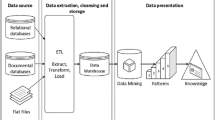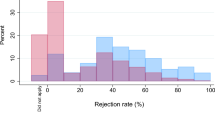Abstract
Often, demographers charged with projecting enrollments for school districts are asked to provide a range of future enrollments, as point estimates are not satisfactory to stakeholders. Three New Jersey school districts in varying populations sizes (small, medium, and large) were used to project enrollments 5 years into the future. Prediction bands were created using empirically-based methods, whereby confidence intervals were constructed, and by model-based methods, which utilizes stochastic forecasting. While stochastic forecasting is typically used in projecting the population of large geographies such as states or countries, it has rarely been used for a small level of geography such as a school district. The results showed that confidence intervals may have limited utility in projecting an enrollment range for larger districts, particularly in the short term (1–2 years). Prediction intervals using stochastic forecasting have limited utility in school district projections, regardless of school district size, as the prediction bands are too wide to allow for any meaningful use of the data.







Similar content being viewed by others
Notes
The authors can be contacted to receive the programming code used for this paper.
References
Alho, J. M. (1990). Stochastic methods in population forecasting. International Journal of Forecasting,6(4), 521–530.
Andersen, M., Cole, R. Dunn, T., Krupka, D., & Pato, J. (2014). Forecasts for the Lexington Public Schools: FY2015-FY2020 Report of the enrollment working group, Report prepared for District.
Keilman, N., Pham, D. Q., & Hetland, A. (2002). Why population forecasts should be probabilistic—illustrated by the case of Norway. Demographic Research,6(15), 409–454.
Keyfitz, N. (1972). On future population. Journal of the American Statistical Association,67, 347–362.
Keyfitz, N. (1981). The limits of population forecasting. Population and Development Review,7, 579–593.
Lapkoff & Gobalet. Demographic Research Inc. Report for San Francisco Unified School District, November 23, 2015. Report prepared for District.
Lapkoff, S., & Gobalet, J. Forecasting School Enrollments: Demographic Tools to Help Schools Prepare for Change. Draft, February 2019. lapkoff@demographers.com, Gobalet@demographers.com
Pflaumer, P. (1988). Confidence intervals for population projections based on monte carlo methods. International Journal of Forecasting,4(1), 135–142.
R Core Team. (2013). R: A language and environment for statistical computing. Vienna: R Foundation for Statistical Computing.
Rayer, S., Smith, S. K., & Tayman, J. (2009). Empirical prediction intervals for county population forecasts. Population Research and Policy Review,28(6), 773–793.
Smith, S. K., Tayman, J., & Swanson, D. A. (2001). State and local population projections: Methodology and analysis. New York: Kluwer Academic/Plenum Publishers.
Tayman, J. (2011). Assessing uncertainty in small area forecasts: State of the practice and implementation strategy. Population Research and Policy Review,30(5), 781–800.
Tayman, J., Schafer, E., & Carter, L. (1998). The role of population size in the determination and prediction of population forecast errors: An evaluation using confidence intervals for subcounty areas. Population Research and Policy Review,17(1), 1–20.
Author information
Authors and Affiliations
Corresponding author
Additional information
Publisher's Note
Springer Nature remains neutral with regard to jurisdictional claims in published maps and institutional affiliations.
Rights and permissions
About this article
Cite this article
Grip, R.S., Grip, M.L. Using Multiple Methods to Provide Prediction Bands of K-12 Enrollment Projections. Popul Res Policy Rev 39, 1–22 (2020). https://doi.org/10.1007/s11113-019-09533-2
Received:
Accepted:
Published:
Issue Date:
DOI: https://doi.org/10.1007/s11113-019-09533-2




